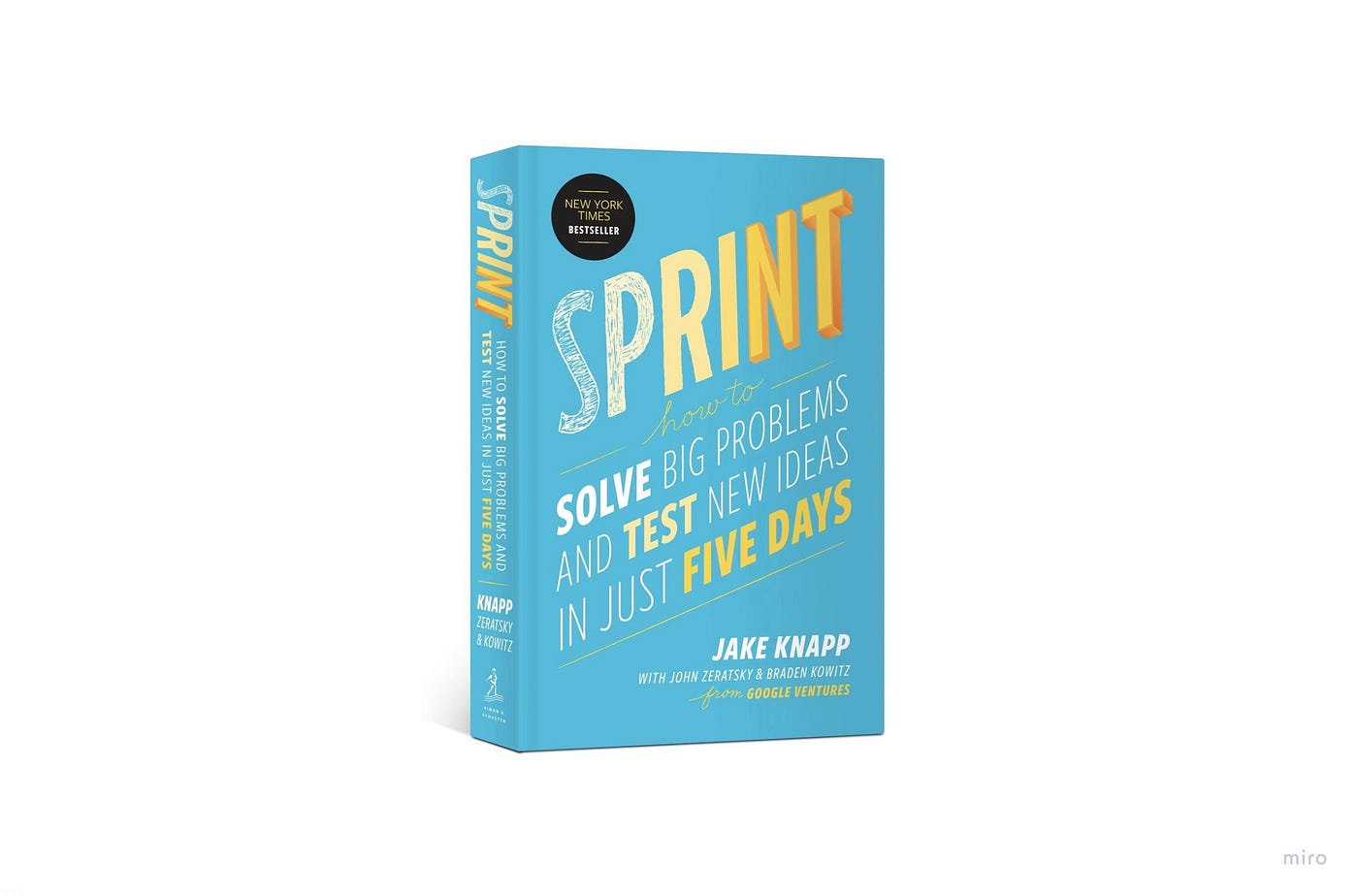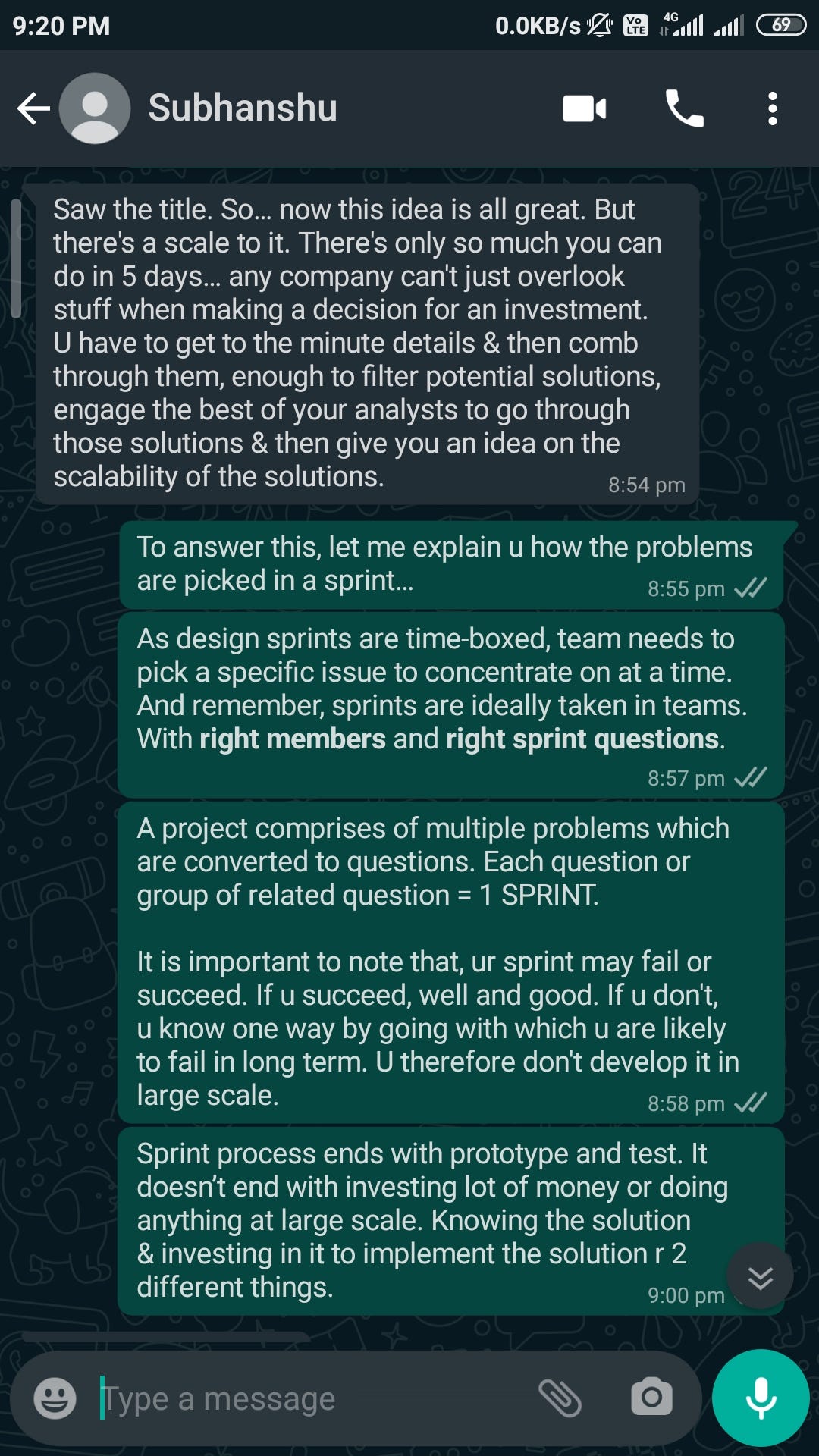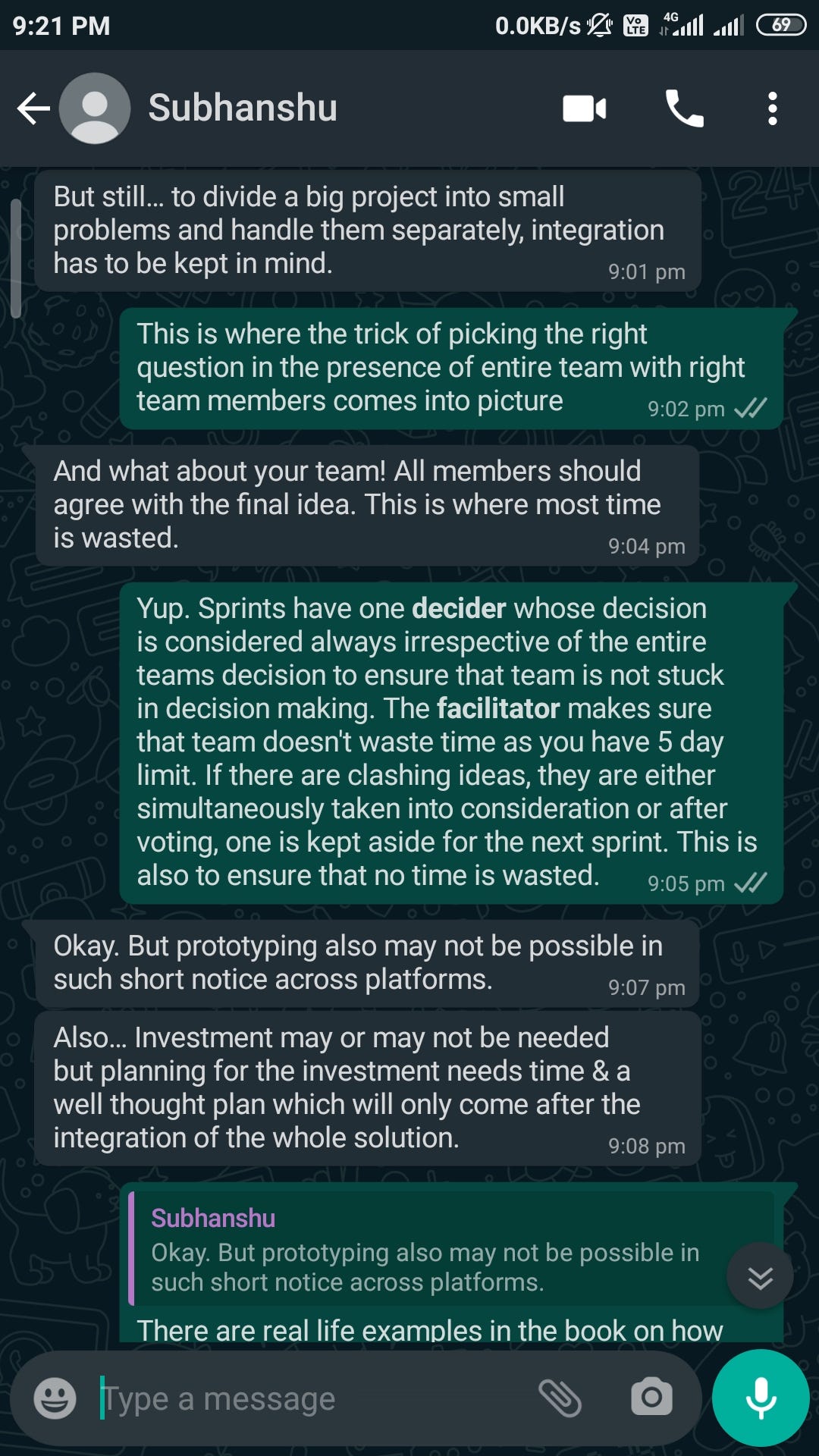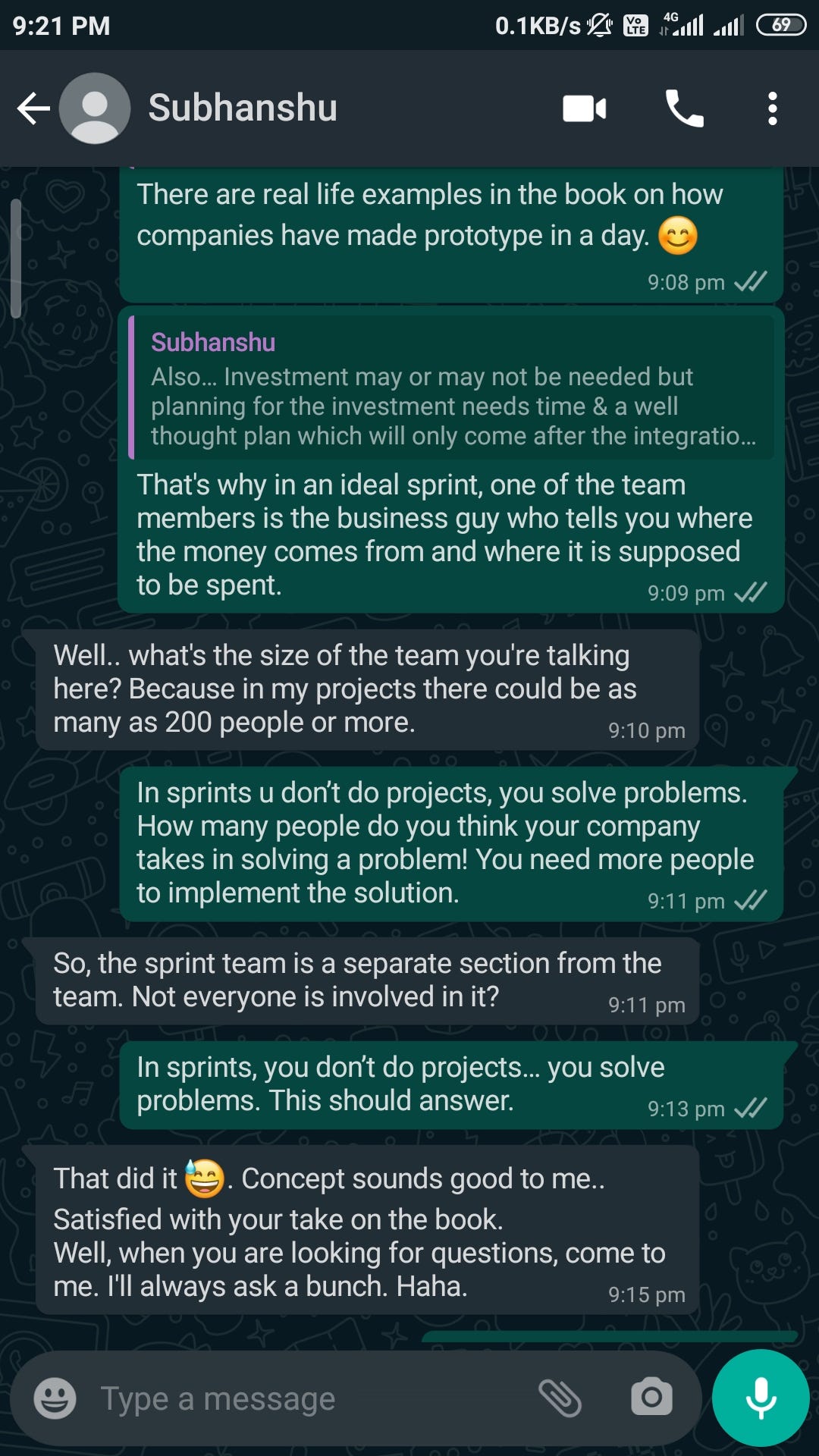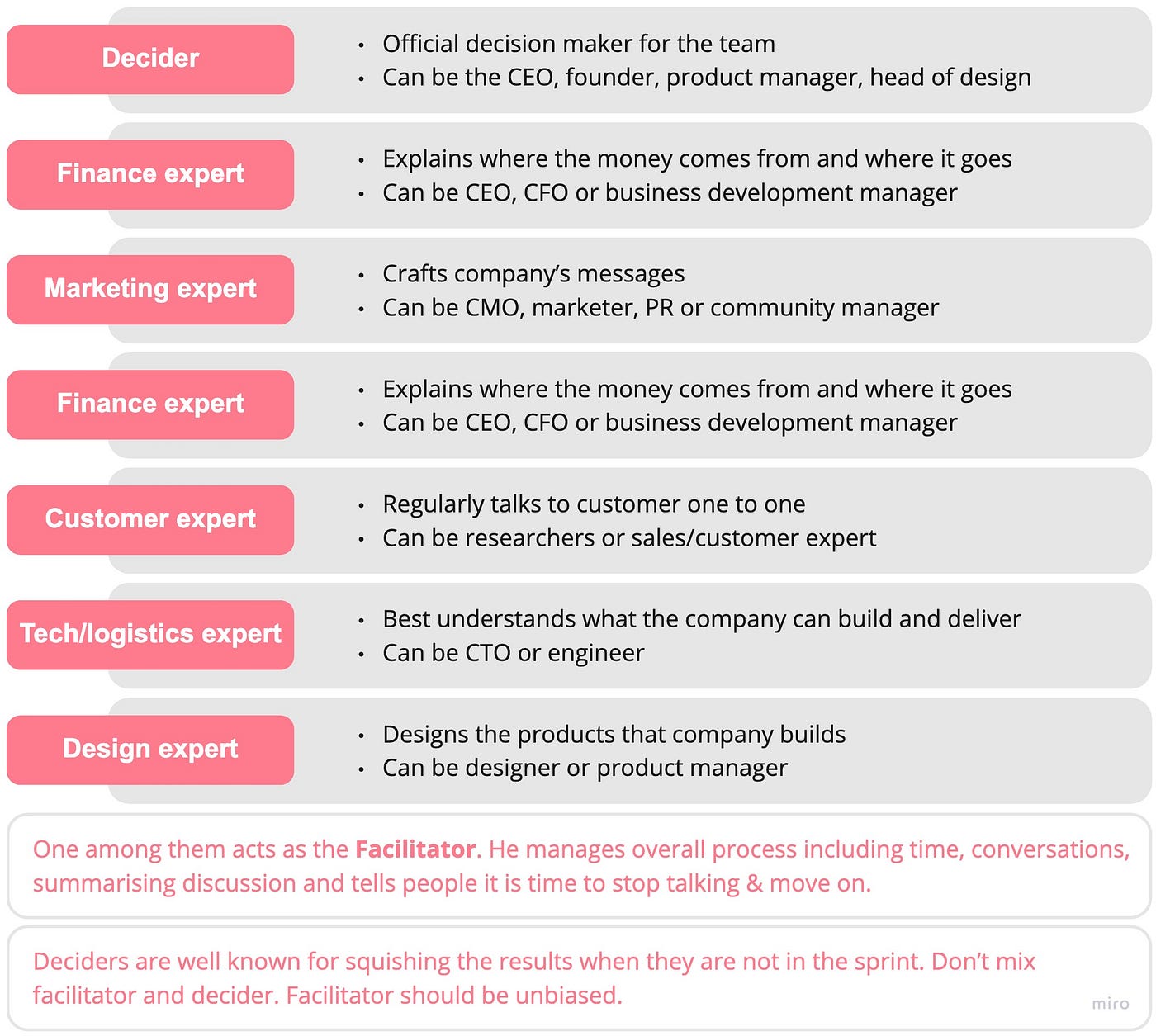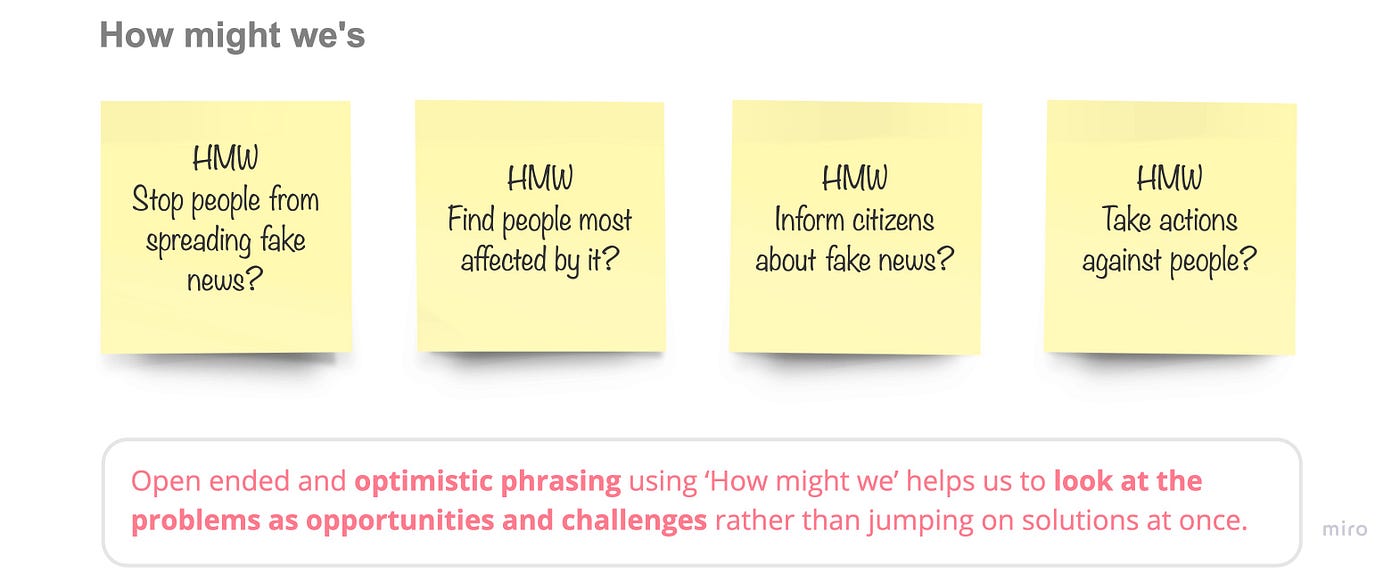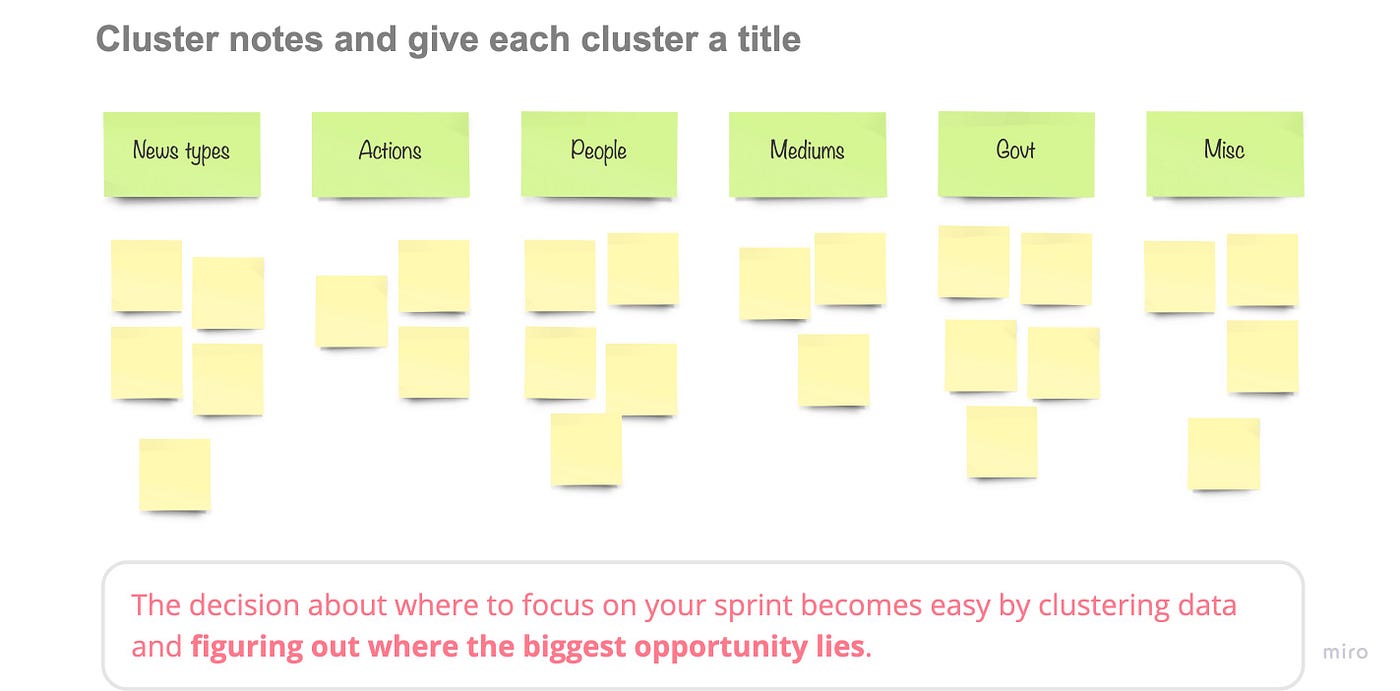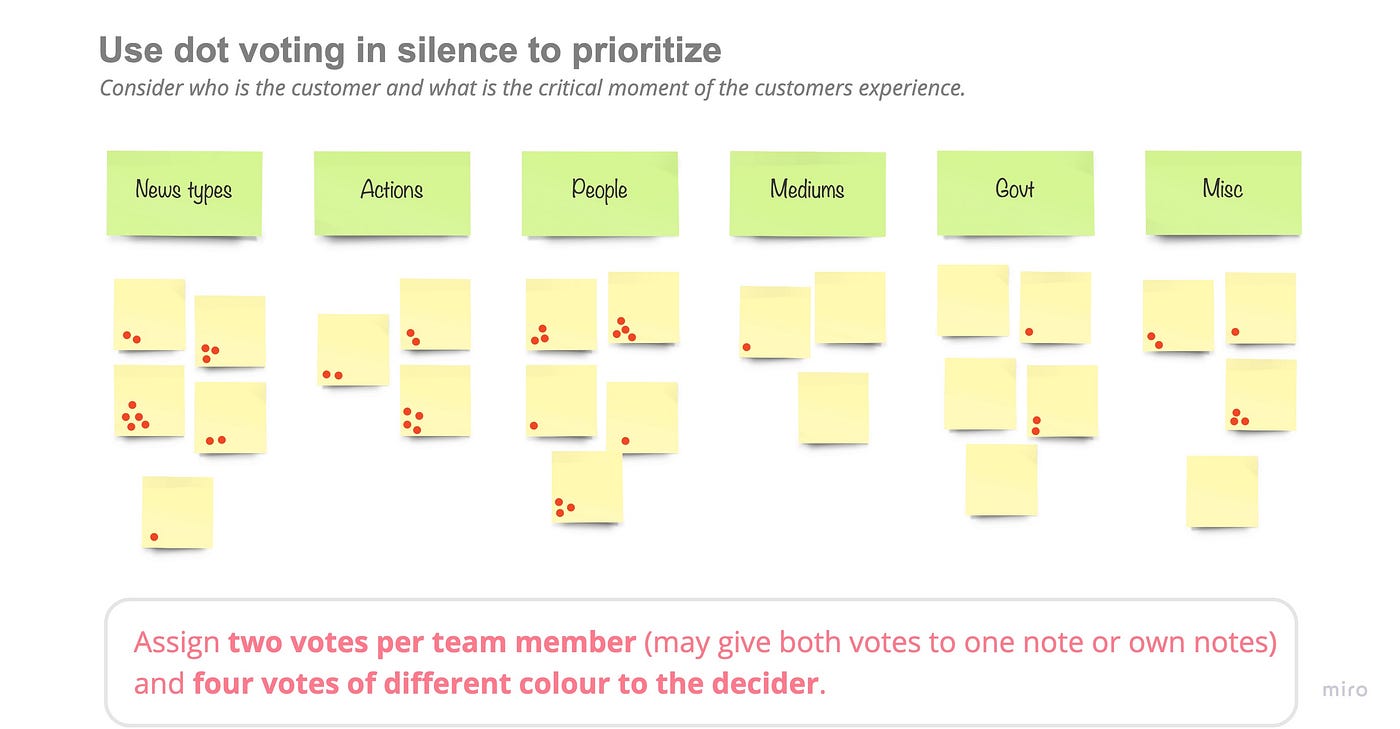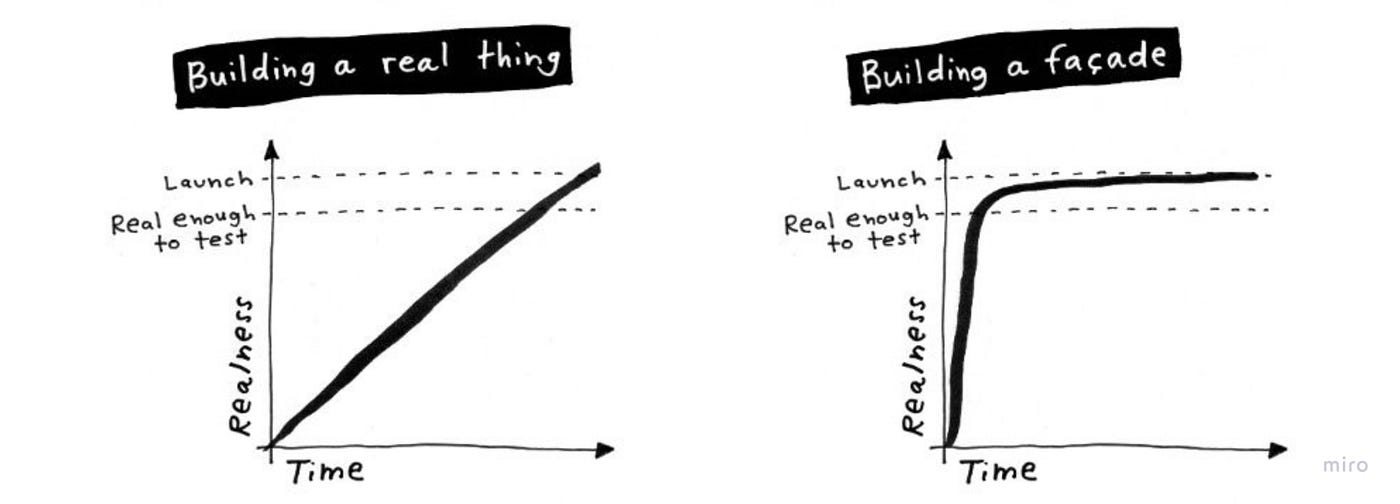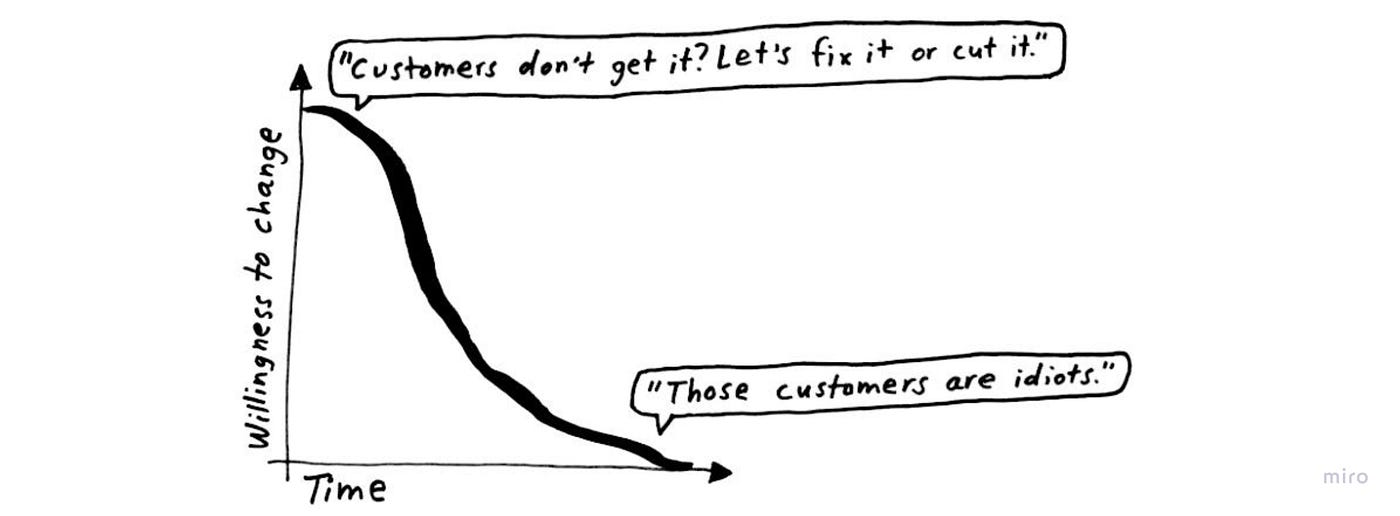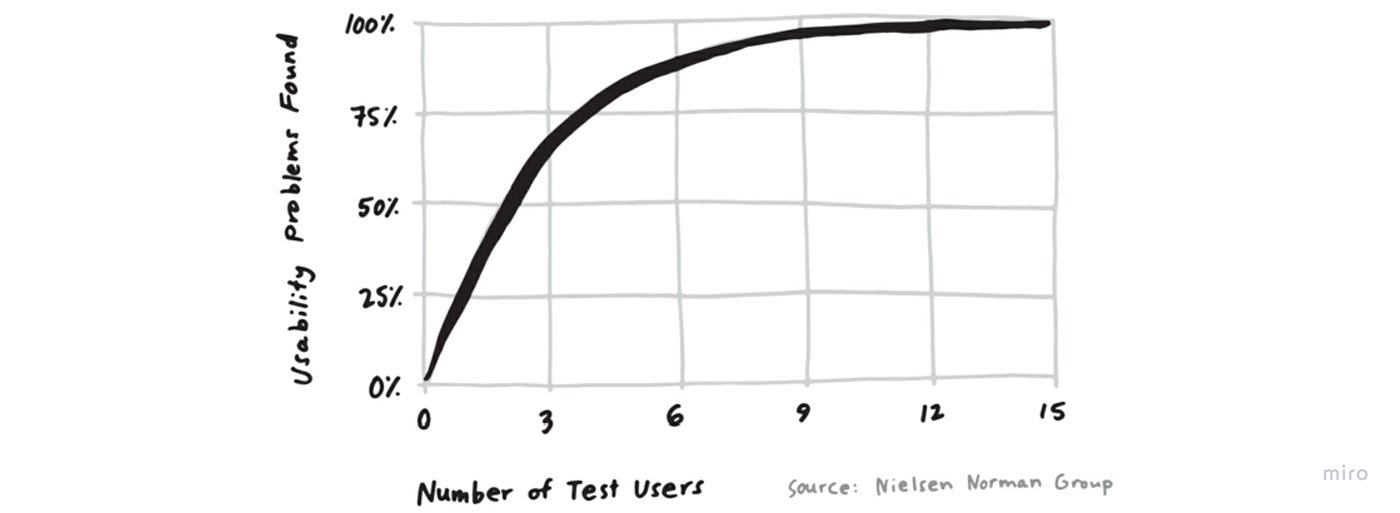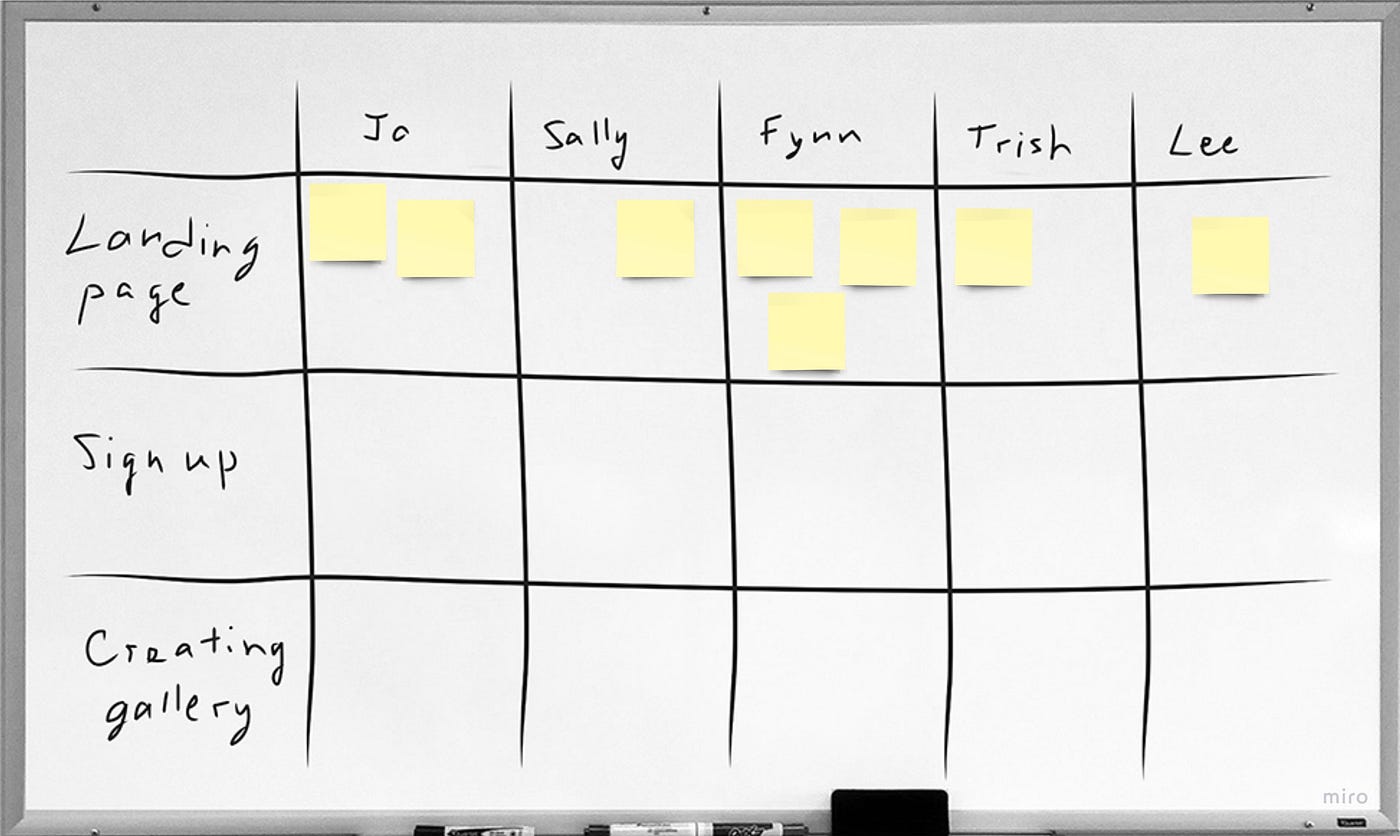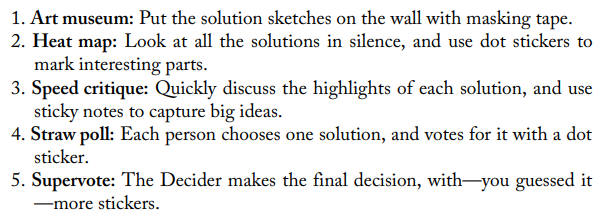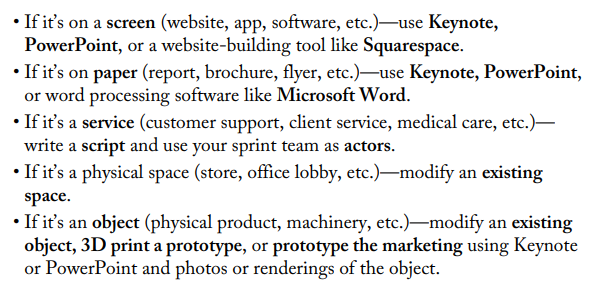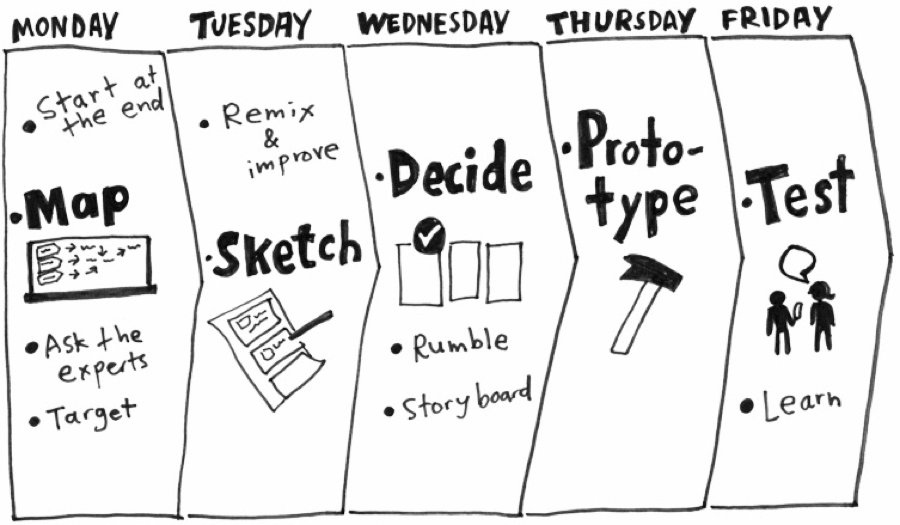Sprint how to solve big problems and test new ideas in just five days
Sprint how to solve big problems and test new ideas in just five days
Solve big problems and test new ideas using Sprints in just 5 days
Learnings from the book by Jake Knapp, John Zeratsky and Braden Kowitz of Google ventures
The Sprint is a Google venture’s process for answering crucial questions through prototyping and testing ideas with target customers in only 5-days, saving your and your team’s countless hours and money. Sprints can be used for prioritisation, marketing strategy, naming companies etc.
Before publishing the article, I shared the draft with one of my friends. Talking to him helped me understand the questions that might arise in people’s mind by looking at the title of the book. Here is how the conversation went.
Reason to go with sprint
Test fast, fail fast, adjust first. _Tom Peters (Coauthor, In Search of Excellence )
New ideas usually fail when we are overconfident about how well customer would understand and how much they would care. Sprint lets us solve the surface first by working backwards to figure out underlying system and technology.
Sprint rules
The simultaneous visibility of these project materials help us identify patterns and encourage creative synthesis to occur much more readily than when these resources are hidden away in folders, notebooks or power point decks.
_Tim Brown in his book ‘Change by Design’
MONDAY: MAP
Start at the end
Writing a clear goal helps focus on the right problems. Think, if you would jump to the end of your sprint, what would you have answered or what would you have improved. Note down all possible goals that your team might want to achieve.
Set long term goals
Note what can cause failure. Turn these assumptions and obstacles into questions. Discuss, what among these has to be true to meet the goal. Answer them.
Turning potential problem into questions makes them easier to track, easier to answer with sketches, prototypes and tests. It creates a shift from uncertainty to curiosity. By seeing them listed at one place reduces the fear of not knowing what you are afraid of.
Including only major user centric steps(not detailed) helps narrow down broader challenges into specific target for the sprint and provides structure for the solution.
Ask the experts
Check previous efforts/failures in the area and examine pre-existing solutions. Find and tell experts about the sprint. Ask them to review the progress. Ask what they already know about the topic. Enquire, where you might go wrong. Ask them to retell you what they think you already know. Ask what is incomplete. Ask what opportunities they can see. Experts will tell you things that you wouldn’t know how to ask.
Ask why, even if you know the answer. Conveying the obvious ensures that there is no interpretation. It often draws detail that not everyone is clear about.
Update your questions and goals accordingly. Note every important fact on the wall. Use ‘How might we?’ method developed by Procter and Gamble to organise and prioritise team member’s notes. Each person writes their own ideas/notes on sticky notes starting with “How might we”.
Then move prioritised notes from the group and stick in one place.
TUESDAY: SKETCH
Remix and improve
Use Lightning Demos. Ask team members one by one give 3-minute tours to their ideas and tell what’s cool about it. Looking at similar product from same industry may not be very benefiting. One can get more ideas by looking at similar problems in different environments. Look at the ideas inside your own organisation. Look for ideas that are in progress or have been abandoned. Most won’t turn into anything, but ½ may inspire great solutions.
Sprints aren’t about new ideas but better non existing ideas. Great innovations are built on existing ideas, repurposed with vision.
Sketch
Sketches help develop individual ideas while working alone. They help convert abstract ideas to concrete solutions which can be fairly evaluated by the team.
Work alone together. Working alone gives pressure of responsibility along with offering time to research, think about a problem and find inspiration.
The best idea come from people when they are alone and not from brainstorming. Maybe because there isn’t enough time in these session to think deeply.
_ Excerpt from the book
Plan how to recruit testers for Friday
Someone(except the facilitator) needs to take this responsibility. You may post something generic to attract audience than link it to a screener.
Steps recommended to create the screener survey:
WEDNESDAY: DECIDE
Rumble
When you end up with more than one winning sketches, you may prototype both or postpone one for now. In case winning sketches conflict with one another or maybe can’t co-exist in same prototype, note and use dot vote to save time.
Storyboard
10–15 panels connected into a cohesive story makes it easier to spot problems before prototyping. It removes all guesswork on what to include.
Draw a 5 X 3 grid on the whiteboard. Discuss each step with the team and start filling boxes in each step. 1st scene should be the best opening scene for the prototype. Try placing your product among web search results, magazines with ads, place beside the competitor in a store shelf, show app store view, news article mentioning your service, etc.
In case something wasn’t discussed during the week, ignore it for Friday’s test. Or fill that section from maybe later sketches or from existing products. Avoid any new invention to save time. Make notes of new ‘might include’ ideas for later. 1st finish the sprint. Include only enough details. Take risks when in doubt.
Each scene in the storyboard should ideally take 1 minute to test. While testing users should get enough time to think aloud and answer questions.
THURSDAY: PROTOTYPE
Divide the team.
Use ‘Fake it’ philosophy (not ‘perfect’ but ‘just enough’) to turn story board into a prototype. Just make sure that your prototype appears real. We cannot expect users to imagine.
The ideal prototype should have Goldilocks quality. Not too high, not too low, but just right.
Keep revisiting sprint questions. Trial run in presence of the entire team around 3 pm so that you still have time to patch any holes, if found. If you are not sure whether any bold idea is going to work, it’s better to find it early. The longer you append, the more your team gets attached to it. After one day you are receptive to feedback, later you get committed to the idea.
FRIDAY
“There is this gap between the vision and the customer. To make the two fit, you have to talk to people.” _ Joe Gebbia 2008 (Airbnb)
Testing with target audience helps know their reaction before making expensive commitment to launch. 5 interviews should be enough to trace patterns/faults.
One team member acts as the interviewer while other members observe the live/recorded video of the interview. Testers are asked to test competitor’s products before coming for Friday’s test.
Interviewer follows the following steps to find the answers to why things work or don’t work.
Meanwhile other members watch the video of the interview. When they hear something interesting, they write it in form of quotes, observations or interpretations on sticky notes and place it on the table drawn on the whiteboard.
Write + or — in case of positive or negative comments respectively. Leave it blank if neutral. At the end, each member stands in front of the chart and silently reviews. As a team they analyse the sticky notes later to find patterns. If there are any major points, they are worked on before closing the sprint.
Not wasting time in endless meetings, but working together WITH THE RIGHT MIX OF PEOPLE to build something that matters to real people is best use of your time. This is sprint.
Спринт
Как разработать и протестировать новый продукт всего за пять дней
О чем
Существует множество методов разработки новых продуктов, но все они требуют времени. Поэтому в Google разработали «Спринт» — методику, которая позволяет протестировать любую идею всего за пять дней. Книга рассказывает о «спринте» всё: как создать новый продукт за одну рабочую неделю, протестировать его на потенциальных потребителях, определить дальнейшую бизнес-стратегию и свести к минимуму все возможные риски.
«»Спринт» работал. С его помощью мы придумывали идеи, тестировали их, реализовывали и давали им путевку в жизнь. И что самое важное — они выживали в реальных условиях, успешно демонстрируя свою состоятельность. Постепенно «спринтом» заразился весь Google: этот метод взяло на вооружение множество команд, он проник во множество кабинетов».
Зачем читать
Книга отвечает на основные вопросы, стоящие перед компанией:
Авторы помогли использовать «спринт» сотням стартапов, а книга моментально стала мировым бестселлером.
Об авторах
Отзывы экспертов
Ключевые понятия
Работал в Google, затем перешел в Google Ventures, где и разработал свою методику сверхбыстрого тестирования новых идей. С тех пор провел сотни «спринтов» для таких стартапов, как 23 and Me, Slack, Nest и Foundation Medicine.
Руководил разработкой дизайна Gmail, Google Apps for business, «Google Таблицы» и «Google Тренды». Во время работы в Google Ventures помог более чем 200 стартапам.
Работал дизайнером в YouТube и Google Ventures, пишет о дизайне и продуктивности для The Wall Street Journal, Fast Company и Wired.
«Эта книга полезна двум категориям людей. Во-первых, тем, кто думает, что новые вещи надо обязательно делать долго и сложно. Нет, это не так. Надо уметь создавать новое быстро, иначе можно опоздать. Во-вторых, тем, кто считает, что новые вещи надо клепать на коленке, как бог на душу положит. Нет, это не так. Надо уметь делать быстро, но с умом. Так что, книгу стоит прочитать тем, кто хочет сменить девиз „слабоумие и отвага“ на „здравый смыс и скорость“, но еще не знает как».
«„Спринт“ дает вам универсальную формулу для тестирования идей, которая будет работать и в стартапах, и в больших компаниях. За пять дней вы пройдете путь от идеи до прототипа и решения, что сэкономит вам кучу времени и денег. Обязательная книга для каждого предпринимателя».
Отзывы
Отзывы
Хотите тираж со своим логотипом?
Поможем повысить лояльность сотрудников и сформировать корпоративную культуру.
А также саммари, аудиокниги, тесты, курсы и видео — в корпоративной библиотеке Alpina Digital. Подключайте своих сотрудников!
Форма успешно отправлена.
2022, ООО «Альпина Диджитал»
Все права защищены
Успешно!
Добавьте его — и вам больше не придется вводить логин и пароль.
Book Notes — Sprint: How to Solve Big Problems and Test New Ideas in Just Five Days
Set the stage
Start with a big problem
Sprints are not for long-term projects; it is useful for situations with high stakes, not enough time, and projects that are hard to start.
Sprint forces the team to focus on the most pressing questions; it allows you to learn from just the surface of a finished product.
Get a Decider, a Facilitator, and a diverse team.
The team needs someone with authority to make decisions, could be a CEO or a VP, product manager, who understands the problem in-depth and have strong opinions and criteria to help find the right solution.
The ideal team size for a sprint is seven people or fewer. You’ll need engineers, designers, and product managers, and people who have deep expertise and are excited about the challenge. A sprint team also needs someone with strong contrary opinions about the idea.
Schedule five days and find the right room
The sprint team must be in the same room Mon-Thur from 10 am to 5 pm, and 9 am to 5 pm on Friday. During the sprint, no laptops, phones, or iPad were allowed.
Get two big whiteboards, IdeaPaint, and paper.
Monday
Agree to a long-term goal
The team needs to lay out the long-term goal and the difficult questions that must be answered. “Why are we doing this project? Where do we want to be six months, a year, or even five years from now?” The goal should reflect the team’s principles and aspirations. Write it at the top of the whiteboard once the goal is decided.
Questions that need to be discussed:
Create a map to pick the specific target for the sprint
The map should include significant steps required for customers to move from beginning to completion.
Follow these steps to create a map.”
Ask the experts
Interview someone that can cover:
Ask, “What will make this project a success?” “What’s our unique advantage or opportunity?” “What’s the biggest risk?”
When talking to the expert, five things to keep in mind are
Set a target for your sprint
The Decider needs to choose one target customer and one target event
By Monday afternoon, you’ve identified a long-term goal and the questions to answer along the way. You’ve made a map and circled the target for your sprint. Everyone on the team will have the same information, and everyone will understand the week’s objective. Next, on Tuesday, it’ll be time to come up with solutions.
Tuesday
Collecting and synthesize the existing ideas in Lightning Demos.
Sketch
Sketching is the easiest way to translate abstract ideas into concrete solutions. It allows every person to develop those specific ideas while working alone.
The four-step sketch
Copy down the long-term goal, look at the map, How Might We questions and the notes from lightning demos, write down anything that looks useful.
Wednesday
Evaluate solutions, critique, then decide.
When you have two good, conflicting ideas, you can prototype both, then test on Friday.
Storyboard
Take the winning sketches and string them onto a storyboard, to imagine your finished prototype, and show how the prototype would work, so you can spot problems and points of confusion before the prototype is built.
Thursday
Adopt a ‘fake it’ philosophy to turn the storyboard into a realistic prototype.
The prototype mindset
Four important exercises:
2. Divide and conquer
The sprint team should split into makers, stitchers, writers, asset collectors, and interviewer.
3. Stitch it together
Stitcher should make certain dates, times, names, and other contents are consistent throughout the prototype.
4. Do a trial run
Do the trial run around 3 pm. Double-check against the storyboard to make sure everything made it into the prototype.
Friday
Friday, you would interview customers and learn by watching them react to your prototype.
Five-Act Interview
No particular tech setup required, only a regular laptop with a webcam.
Learn
Everyone on the team watches the interviews together. Take notes and stick them to the whiteboard.
Liftoff
Instead of jumping right into solutions, take your time to map out the problem and agree on an initial target. Start slowly so you can go fast.
Instead of shouting out ideas, work independently to make detailed sketches of possible solutions. Group brainstorming is broken, but there is a better way.
Instead of abstract debate and endless meetings, use voting and a Decider to make crisp decisions that reflect your team’s priorities. It’s the wisdom of the crowd without the groupthink.
Instead of getting all the details right before testing your solution, create a façade. Adopt the “prototype mindset” so you can learn quickly.
And instead of guessing and hoping you’re on the right track — all the while investing piles of money and months of time into your ideas — test your prototype with target customers and get their honest reactions.
Sprint:В How to Solve Big Problems andВ Test New Ideas in Just Five Days
2,000+ Amazon Reviews
18,000+ Goodreads Ratings
Available in 20+ languages
Get the Sprint Bonus Pack
About the book
Entrepreneurs and leaders face big questions every day: What’s the most important place to focus your effort, and how do you start? What will your idea look like in real life? How many meetings and discussions does it take before you can be sure you have the right solution?
Now there’s a surefire way to answer these important questions: the Design Sprint. Designer Jake Knapp created the five-day process at Google, where sprints were used on everything from Google Search to Google X. He joined Braden Kowitz and John Zeratsky at Google Ventures, and together they have completed more than a hundred sprints with companies in mobile, e-commerce, healthcare, finance, and more.
A practical guide to answering critical business questions, Sprint is a book for teams of any size, from small startups to Fortune 100s, from teachers to nonprofits. It’s for anyone with a big opportunity, problem, or idea who needs to get answers today.
“Read this book and do what it says if you want to build better products faster.”
—Ev Williams, Founder of Twitter and Medium
“Jake Knapp and the team at Google Ventures have refined an efficient, hands-on approach to solving your product, service and experience design challenges.”
—Tim Brown, CEO of IDEO
“Powerful methods for hatching ideas, solving problems, and testing solutions.”
—Charles Duhigg, Author of The Power of Habit
“Every business leader I know worries about the same thing: Are we moving fast enough? The genius of Sprint is its step-by-step breakdown of what it takes to do work that matters with speed and urgency. A sprint is a cure for what ails companies in an ever faster world.”
—Beth Comstock, Vice Chair of GE
“A transformative formula for testing ideas that works whether you’re at a startup or a large organization.”
—Eric Ries, Author of The Lean Startup
“Sprint teaches you a novel process for solving really thorny problems in just 5 days. It’s full of helpful, entertaining stories that will make it easier for you to succeed. What more do you want from a book? I wish all business books were this useful.”
—Dan Heath, Author of Made to Stick
The official step-by-step guide to running a DesignВ Sprint
About the authors
Jake Knapp spent 10 years at Google and Google Ventures, where he created the Design Sprint process. He’s written two books, Sprint and Make Time, coached teams at places like Slack, LEGO, IDEO, and NASA, and has been a guest instructor at MIT and the Harvard Business School.
John Zeratsky is a co-founder and startup investor at Character, bestselling author of Sprint and Make Time, and former design partner at GV. Previously, John was a design leader for YouTube, Google Ads, and FeedBurner, which was acquired by Google in 2007.
Braden Kowitz is a product designer and the co-founder of Range. He founded the Google Ventures design team in 2009 and pioneered the role of “design partner” at a venture capital firm. Before GV, he was an early designer at Google and studied Human-Computer Interaction at Carnegie Mellon.
Solve Big Problems & Test New Ideas In Just 5 Days
This blog will teach you the process of running a “design sprint” — a method developed by Jake Knapp, a partner at Google Ventures — to solve big problems and test new ideas in just five days.
Most teams often invest months, even years, in developing a product or service — only to discover they’ve built something that no one wants.
Jake developed a method that helps teams make better use of time and resources by simulating the entire product development process in just five days.
A design sprint helps teams filter ideas and gain clarity as to which of them are best to pursue.
Let’s dive in and see what that process looks like at a high level, and how to implement it.
For more a more detailed, step-by-step process, check out Jake’s book.
Preparing for the Sprint
To kick-off a design sprint, your goal is to assemble a diverse team from within your company of five to eight experts in different areas of the business.
Jake notes that the sweet spot here is seven people — any more will only “create drag.”
An ideal team involves representation from the engineering, sales, customer support and marketing departments, as well as, critically, “the Decision Maker.”
Each person brings a key understanding to the process: engineering understands product capabilities, sales understands customer preferences, customer support sees customer challenges, and marketing holds key insights that tie it all together.
Over the course of the next five days, the team will develop and test a number of different things. You can run sprints on key features (What should my landing page look like? How should we price it?), product variations (Do people prefer this type of product or something else?), or entirely new businesses (Does this business solve a key problem for a customer? Are they willing to pay for this product?).
Here’s how the five key days play out…
Day 1: Monday — Map and Define the Problem
Day 1 is about defining the problem you want to solve.
The decisionmaker in the group should facilitate the agreement around a long-term goal. What the company or product should achieve in, say, eight months’ time. Make sure everyone is aligned and excited about this goal, write it down and post it on the wall.
Then, map out a series of difficult questions, potential barriers to achieving that goal:
After you’ve mapped out the questions, spend time trying to answer the most important of them based on the information you know.
Next, brainstorm and list as many different types of customers (demographics) that you believe have the problem you are trying to solve. Now pick one (either the one you best understand or the largest cohort). This is the customer for whom you are going to be (designing) running the design sprint.
Based on this understanding, one team member is next assigned to recruit five real potential customers who fit these characteristics from outside the company. These five people will be asked to physically show up on Friday to test the product you’re designing.
Why five? Back in the 90s, Jakob Nielsen did a study to answer this question: “How many interviews does it take to spot the most important patterns?”
It turns out that 85 percent of the problems were observed after just FIVE people reviewed a product!
Additionally, the deadline of actual customers coming in five days creates an added incentive to have a workable product finished by then.
The team’s last task for Day 1 is to Ask the Experts. Somebody out in the world knows “the most” about your customers; somebody knows the most about the technology, the marketing channels, the business, and so on. Your goal is to find them and pick their brains.
This is usually where people find the most exciting ideas.
Day 2: Tuesday — Create Solutions
Jake compares ideas in product design to LEGO bricks: they can be combined and recombined in new ways to create something better.
On Day 2, the team first sketches (literally, on large sticky notes) competitors’ solutions and puts them up on the wall for everyone to see.
Next, each team member sketches new solutions that combine these “LEGO bricks” to address the problem identified on Day 1.
Each person does their sketching on their own and submits their sketches anonymously. Each member can submit one, two or even three solutions.
This individual process prevents the groupthink that occurs with traditional brainstorming.
The goal is for each individual to create fully fleshed out ideas, empowering introverted team members to contribute equally.
Note: You need to be quite thorough with these sketches — they should illustrate how the solution would work for the target customer, what the customer sees going through the app or website, and so on… They can be rough, but they should be very detailed and precise.
Day 3: Wednesday — Downselect
Suspense is high coming in on Wednesday morning. The team tapes up sketches and everyone marks their favorite ideas with a dot.
The team engages in a timed critique of each concept. Interestingly, the person who sketched it isn’t allowed to speak until the end. This minimizes bias and ensures the process is truly meritocratic, allowing people to be as honest as possible with their critique.
In a group of seven sprint participants, there may be anywhere from seven to 15 proposed storyboard solutions.
The team votes on the solutions they believe in and are most excited about testing.
The clincher, however, is that The Decision Maker casts “super-votes,” which supersede all other votes, choosing up to three solutions to test fully on Friday. Ideally, though, you pick the best single prototype to answer the question you defined at the beginning of the week.
Next, create a storyboard. The team should flesh out the top idea(s), detailing everything from discovery (i.e. how a user comes across the product for the first time — for example, on a store shelf, via a web search or news article) to every other part of the user experience.
In other words, this storyboard needs to be able to stand alone without a verbal explanation, so it may be evaluated in an unbiased manner, on their merits alone, not based on who created the storyboard.
The next step is to take the idea beyond the storyboard and transform it into a high-resolution mockup that looks and feels like an actual product.
Day 4: Thursday — Put It All Together & Build the Mockup
Once the team has an idea of how everything will look and feel, they assign tasks to different team members to build a prototype.
A good rule of thumb is: Build just enough to learn, but not more…
These prototypes don’t have to be fully functional, but they should look like they are. Buttons might not fully work, but when pressed should drive the customer down a different path…
Jake calls this “Goldilocks Quality” — the prototype should have just enough quality to evoke honest reactions from customers.
After team members build their mockup, the team regroups to connect the pieces and flesh out the full experience they want to put their five clients through tomorrow. They need to assure everything appears realistic and cohesive.
Day 5: Friday — Observe Customer Reactions (and Learn!)
Day 5 is when the real fun begins — you get detailed and authentic feedback from real customers.
The five people you recruited on Day 1 have shown up to test the product/prototype.
It’s best to bring them in face-to-face to test the product in person if possible, though videoconferencing can suffice in some cases.
Identify “The Interviewer” on your team — this person will interact one-on-one with your customer, who is testing the product.
The rest of your design team observes customer reactions via live video in a separate room.
The Interviewer asks the customer different questions (you should write a script):
CRITICALLY — The team observes customer reactions, rather than listens to feedback.
This ensures that the insights they glean are as honest as possible.
By the end of this observation, you should be able to see patterns.
You’ll know what’s working well and resonating, and what’s confusing and what people don’t care about.
These insights answer some of the larger questions posed at the beginning of the sprint and inform the direction that the team will head in next.
This knowledge is extremely valuable and gathering it now will save you an incredible amount of time and money later.
What does this mean for you?
Design sprints are an essential tool that entrepreneurs can use to fail fast, rapidly iterate and grow quickly.
For me it’s part of my year-long exploration of how to best ‘experiment’ in building my businesses, products and services.
Working in a group environment successfully is difficult and, as Jake mentioned, A crucial, but overlooked, part of the design process is designing the way in which we work together.
The structured design sprint process enables teams to operate in ways that are effective in gleaning real, actionable insights about what works and what doesn’t.
It empowers individuals with crazy ideas and also squashes ideas that aren’t validated by customers.
If your team is grappling with whether to launch a new feature or product, it’s worth giving a design sprint a try.
You’ll be amazed by the results.
Join Me
This is the sort of conversation we explore at my 250-person executive mastermind group called Abundance 360.
The program is highly selective. If you’d like to be considered, apply here.
Share this with your friends, especially if they are interested in any of the areas outlined above.
This blog is part of a series I am doing on “Hiring, Culture, and Experimentation”. If you have questions or comments about these topics, tweet at me @peterdiamandis and @codyrapp, and we’ll incorporate them into our research.
